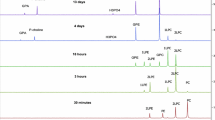Abstract
The synthesis of a series of (1,2-) mixed short/long-chain glycerophosphocholines has been performed. Starting from glycerophosphorylcholine (GPC), and using regioselective acylation in the presence of dibutyltin oxide, a set of high-purity isomeric mixed-chain phospholipids was obtained. This has allowed the development of a simple NMR method for the structural determination of the isomeric 1(2)-short-2(1)-long-diacylglycerophosphocholines. The method is based on the observation that selected protons in the two series of isomeric phospholipids undergo systematic chemical shift variations Δδ that can be ascribed to the acyl substituents on the glycerol backbone. The observed patterns can be exploited as a simple method for the discrimination of regioisomeric unsymmetrical 1,2-diacylglycerophosphocholines.





Similar content being viewed by others
References
Birgbauer E, Chun J (2006) New developments in the biological functions of lysophospholipids. Cell Mol Life Sci 63:2695–2701
Goetzl EJ, An S (1998) Diversity of cellular receptors and functions for the lysophospholipid growth factors lysophosphatidic acid and sphingosine 1-phosphate. FASEB J 12:1589–159
Barenholz Y, Cevc G (2000) Structure and properties of membranes. In: Baskin A, Norde W (eds) Physical chemistry of biological interfaces. Marcel Dekker, New York, pp 171–242
Fuller N, Rand R (2001) The influence of lysolipids on the spontaneous curvature and bending elasticity of phospholipid membranes. Biophys J 81(1):243–254
Muresan AS, Diamant H, Lee KY (2001) Effect of temperature and composition on the formation of nanoscale compartments in phospholipid membrane. J Am Chem Soc 123:6951–6952
Ishii I, Fukushima N, Ye X, Chun J (2004) Lysophospholipids receptors: signalling and biology. Annu Rev Biochem 73:321–354
Bernoud N, Fenard L, Molière P, Dehouck MP, Lagarde M, Cecchelli R, Lecerf J (1999) Preferential transfer of 2-docosahexaneoyl-1-lysophosphatidylcholine through an in vitro blood–brain barrier over unesterified docosahexaenoic acid. J Neurochem 72:338–345
Rosseto R, Hajdu J (2005) A rapid and efficient method for migration-free acylation of lysophospholipids: synthesis of phosphatidylcholines with sn-2-chain terminal reporter groups. Tetrahedron Lett 46:2941–2944
Bayon Y, Croset M, Lagarde M, Lecerf J, Thies F, Frank T, Tayot JL, Chirouze V (1997) Docosahexaenoic acid-containing (lyso)phosphatidylcholines for medicaments for treating cardiovascular disease and cerebral essential fatty acid deficiency. US Patent 5,654,290
D’Arrigo P, Fasoli E, Pedrocchi-Fantoni G, Rossi C, Saraceno C, Tessaro D, Servi S (2007) A practical selective synthesis of mixed short/long chains glycerophosphocholines. Chem Phys Lipids 147:113–118
D’Arrigo P, Servi S (1997) Using phospholipases for phospholipids modification. Trends Biotechnol 15:90–96
Mustratnta A, Forssell P, Poutanen K (1995) Comparison of lipases and phospholipases in the hydrolysis of phospholipids. Process Biochem 30:393–401
Six DA, Edward EA (2000) The expanding superfamily of phospholipase A2 enzymes: classification and characterization. Biochim Biophys Acta 1488:1–19
Beermann C, Mobius M, Winterling N, Schmitt JJ, Boehm G (2005) sn-Position determination of phospholipid-linked fatty acids derived from erythrocytes by liquid chromatography electrospray ionization mass spectrometry. Lipids 40:211–218
Fang J, Barcelona MJ (1998) Structural determination and quantitative analysis of bacterial phospholipids using liquid chromatography/electrospray ionization/mass spectrometry. J Microbiol Methods 33:23–35
Fasoli E, Arnone A, Caligiuri A, D’Arrigo P, de Ferra L, Servi S (2006) Tin-mediated synthesis of lyso-phospholipids. Org Biomol Chem 4:2974–2978
Haasnoot CAG, de Leeuw FAAM, Altona C (1980) The relation between proton–proton NMR coupling constants and substituent electronegativities. I. An empirical generalization of the Karplus equation. Tetrahedron 36:2783–2792
Martin SF, Pitzer GE (2000) Solution conformations of short-chain phosphatidylcholine substrates of the phosphatidylcholine-preferring PLC of Bacillus cereus. Biochim Biophys Acta 1464:104–112
Author information
Authors and Affiliations
Corresponding author
About this article
Cite this article
D’Arrigo, P., Mele, A., Rossi, C. et al. Discrimination of Chain Positions in Mixed Short/Long-Chain Glycerophosphocholines by NMR Chemical Shift Variations. J Am Oil Chem Soc 85, 1005–1011 (2008). https://doi.org/10.1007/s11746-008-1280-4
Received:
Revised:
Accepted:
Published:
Issue Date:
DOI: https://doi.org/10.1007/s11746-008-1280-4




